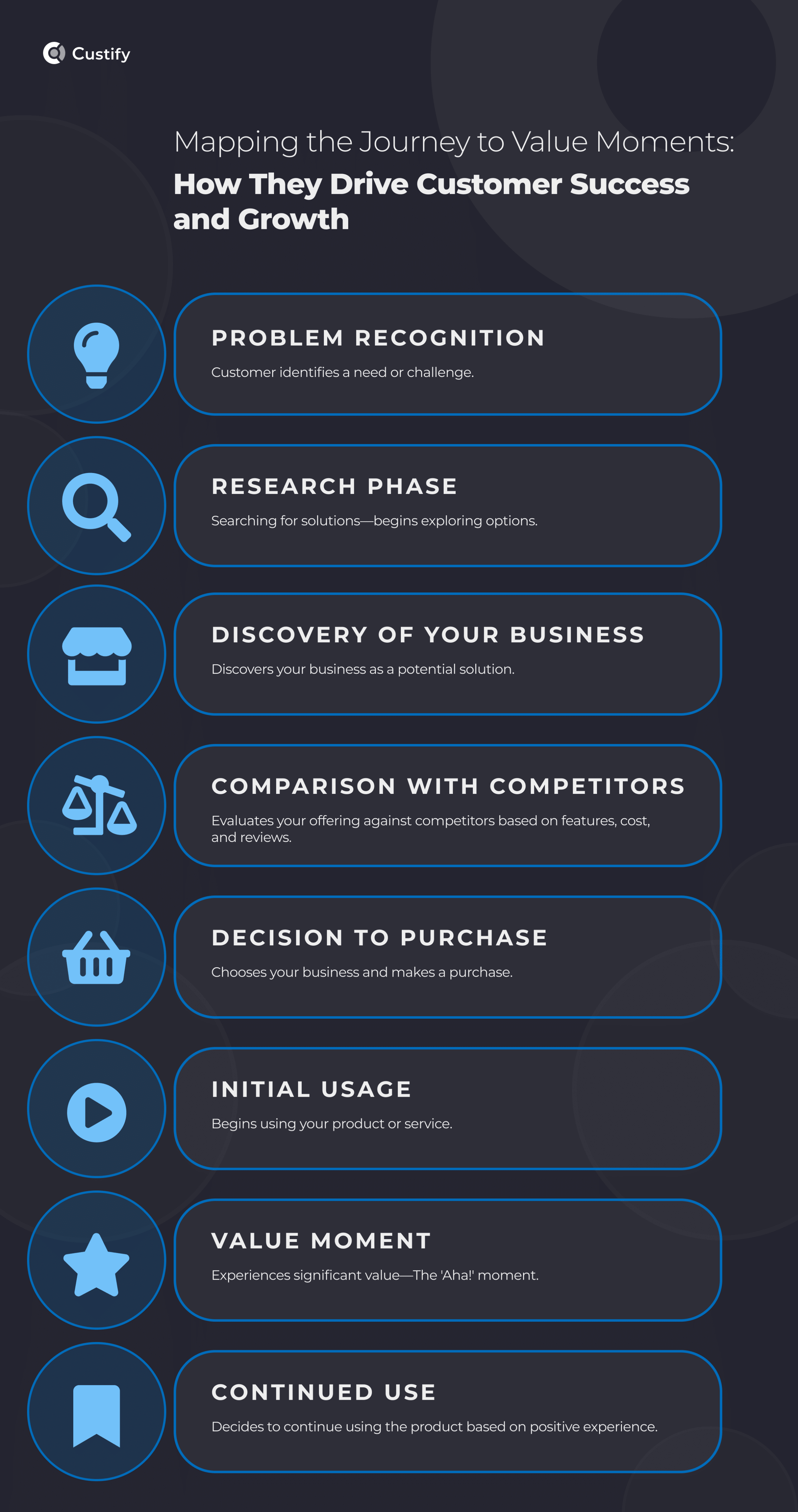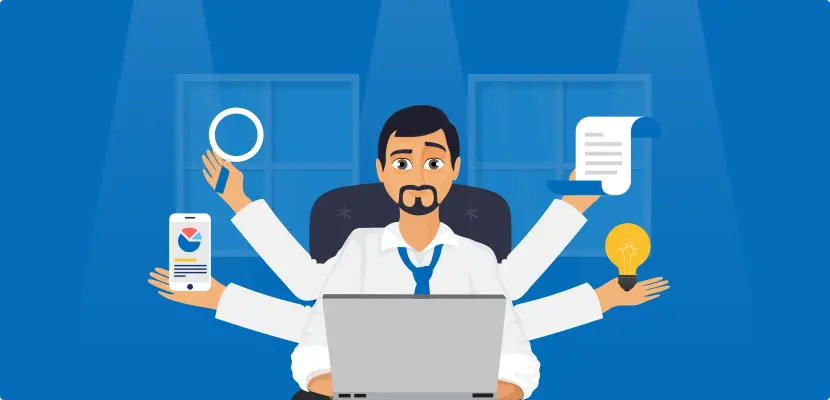Let us begin with a few eye-opening statistics.
Emplifi reports that 61% of customers will pay at least 5% more if they receive a positive customer experience.
According to Gartner, CX drives over two-thirds of customer loyalty.
It’s safe to say that a customer experience is worth its weight in gold.
Now, consider this.
Imagine your last positive experience with a business.
Were you so pleased with the product/service that you left a positive review?
Did you recommend the company to another person?
Did you decide right then and there that you’d continue to purchase from the brand and actively engage with it?
Whatever the case, you reached a value moment.
The brand facilitated interactions, experiences, and deliverables that provided significant value to you — the customer.
This reinforced your decision to choose and continue using its product or service.
That’s how you want your own customers to experience your business.
When you do this, you have an opportunity to create positive impressions, deepen customer relationships, and drive loyalty.
Today, we go in-depth about value moments and how they drive customer success.
What Are Value Moments?
Before we explore what value moments are, let’s first take a moment to look at the user journey as a whole.
- A customer realizes that they have a problem.
- The customer starts researching the problem and looking for a solution to the problem.
- The customer comes across your business.
- The customer compares your business to competitors.
- After researching and considering different factors like reviews, cost, features, etc, the customer chooses your business.
- The customer makes a purchase and starts to use your product/service.
- The customer has a positive experience, finding value in your product. This is the value moment.
- The customer decides that they’ll continue to use your product.

Of course, the customer journey isn’t always this linear.
Customer touchpoints can vary depending on the specific situation.
For example, someone can refer a new customer to your business instead of the customer discovering it on their own.
However, the fact remains that customer success occurs over the course of several moments, during every successful step of the purchasing process — from the moment they discover your brand and fall in love with your products to the minute they get access to your products.

Definition: Value Moments
Value moments are pivotal points during the customer journey where the customer experiences significant benefit, satisfaction, or value from a product or service. These moments are critical because they not only enhance the customer’s immediate experience but also solidify long-term loyalty and advocacy. In the context of the customer journey, value moments can occur at any stage, from initial discovery and purchase to ongoing usage and support.
For example, when a customer first realizes how a feature solves a painful problem, or when they receive exceptional support during a critical time, these are both instances of value moments. Effectively identifying and amplifying these moments can transform a routine interaction into a memorable experience that cements the customer’s emotional and practical attachment to the brand.
So, we can say that a value moment is a specific interaction or experience that marks the moment a customer finds value in your product. Value moments can vary based on the nature of your business and the needs of the customer.
Take another example: let’s say an ecommerce store receives an order from a customer for a product that they need to ship.
To ensure the product gets to the customer in a timely manner, the merchant uses a trustworthy courier service.
What’s the value moment in this situation?
There are two.
For the merchant, it begins the moment the customer receives their product.
Why?
Because the merchant gets value from the courier by delivering the product to the customer on time.
The second value moment occurs when the customer begins utilizing the product and experiences its values.
Let’s say the product is a smart home security system.
The moment the customer — who’s concerned about neighborhood safety — starts getting value from the product is when they start viewing live camera footage on their smartphone, which helps protect them from potential intruders.
The Importance of Value Moments in the Customer Success Journey
Value moments are critical for customer success because they create positive, memorable experiences for customers.
How? By delivering exceptional value, service, or support.
These moments make customers feel appreciated and understood.
As a result, they begin to feel a strong emotional connection to the brand. Not only does this drive customer loyalty, but it also increases the chances of customers referring your business to others.
70% of loyal customers will recommend a brand to people they know after a positive customer experience.
So, if you’re constantly delivering experiences your customers love, then you’re fostering meaningful long-term relationships that potentially attract new clients.
But don’t stop there.
One of the most powerful drivers of exponential growth and customer value maximization is consistently delivering value beyond the initial transaction.
Providing ongoing support and problem resolution is key to driving ongoing customer satisfaction.
Take StudioSuits, for instance, a leading men’s fashion brand.
Beyond offering premium wedding suits and attire, it excels in adding value through continued customer support and education.
By writing insightful blogs on topics like men’s formal wedding attire and style guides, StudioSuits empowers customers to make informed choices, fostering trust and loyalty.

This commitment to ongoing value not only helps with product decision-making but also cultivates a community of satisfied customers who advocate for the brand, ultimately driving its growth and success.
Creating Value Moments for Your Customers – Strategies for CSMs
Here’s a step-by-step guide to help you continuously offer value to your customers.
1. Define Value Moments
Before getting started, figure out the value moments for your particular product or service.
This means you need to determine when your customers will start finding value in your product.
So, for example, maybe you offer collaboration software.
Your value moment occurs when a customer starts using the key features of your software, such as:
- Integrations with other productivity tools
- Instant messaging
- File sharing
To get even more specific, maybe your app tracks:
- Time to resolution (TTR)
- Collaboration activity
- User adoption rate
- Product metrics
- Engagement
These clear performance indicators (KPIs) can help you identify the strengths of your product.
It’s also a great way to understand your value proposition.
Finding your value moments lets you focus more of your time and resources on making and improving them for your customers.
2. Map the Customer Journey
Create detailed customer journey maps that outline customer touchpoints and interactions.
This helps you visualize how customers will experience your brand, product, or service.
It involves creating an actual map that shows the timeline of events, including:
- The first interaction a customer has with your brand (e.g., PPC ad, organic search, referral, website visit, etc.)
- Purchase
- Onboarding emails
- Repeat purchase
- Cancellation

To map your customer journey:
- Identify customer personas. This will help you understand different customer segments. Break customers into groups using their demographics, preferences, pain points, goals, and behaviors. From there, you can tailor the journey map as needed.
- List touchpoints. Make a list of all the customer touchpoints and channels. How did customers interact with your brand? Did they make a website visit? Did they engage with you on social media? Did they respond to your email communication or phone calls? Did they make an in-store visit?
- Map customer actions. Outline the specific actions or behaviors that customers perform during the interaction. Were they researching product options? Did they request a quote? Did they buy an item? Or did they seek customer service?
- Identify emotions and motivations. Emotions will influence every action your customers take. Their emotions will change throughout the customer journey. It’s your job to understand these emotions. Are customers frustrated, curious, excited, or satisfied?
- Highlight obstacles and pain points. Figure out what’s keeping your customers up at night. Determine what’s getting in the way of getting the outcome they want.
After creating your customer journey map, your job isn’t done. Analyze your results to unlock where you can improve.
3. Gather Feedback From Customers
If you need more insights into how you can maximize value moments, go straight to the horse’s mouth — your customers.
Get their feedback through surveys, interviews, and reviews.
As a result, you’ll get a sense of their needs, pain points, and expectations at different stages of their journey.
Use this feedback to align your value moments with their expectations.
For example, Airbnb’s customers wanted more flexibility in their travel plans.

Airbnb used this feedback to introduce features like:
- Flexible cancellation policies
- Extended booking windows
- Customer support
4. Analyze Customer Data
Use data to get actionable insights into customer behavior and preferences.
Data to consider includes:
- Feedback surveys and Net Promoter Score (NPS)
- Social and website analytics
- Product usage frequency
- Average order value
- Support tickets
- Time to-value
- Sales data
5. Create Value-Based Customer Experiences
Data is your friend as you build special value moments that create loyal customers.
So, the steps above are critical.
Once you’ve followed those steps, you’ll know what works. The goal is to design and deliver interactions that provide tangible value.
Apply this to customers at every touchpoint.
The valuable moments you deliver will depend on your business, customer needs, and the type of product or service you offer.
For example, imagine that a customer is planning their child’s birthday party.
They need to buy decorations, party favors, and a gift. However, the customer is short on time due to their busy work schedule.
So, they turned to Amazon for fast shipping.

You can start anywhere, whether you’re an online store like Amazon or a different business altogether.
Use the following tips to make every customer interaction a valuable one.
- Provide seamless omnichannel experiences. Create a similar experience across all customer touchpoints. Think online, offline, mobile, or in-store.
- Engage in proactive communication. Regularly collecting and analyzing customer data will help anticipate their needs. Reach out proactively to offer help, updates, or relevant information.
- Celebrate milestones and achievements. Acknowledge and celebrate important milestones, achievements, or anniversaries in your customers’ journey. Use personalized messaging, special offers, or exclusive rewards.
- Offer value-added services. Complement your core offerings by providing extra services, resources, or benefits.
- Go above and beyond customer expectations. Surprise customers with unexpected gestures, perks, or personalized rewards.
- Enable self-service options. Offer knowledge bases, FAQs, and troubleshooting guides. Tutorials help users find answers to common questions or issues on their own.
Metrics and Measurement
Grasping the impact of value moments on customer relationships and retention is key. By measuring this impact, you can fine-tune your strategies and show off the ROI of your efforts. Here are some crucial KPIs that’ll help you see how well your value moments are doing:
Net Promoter Score (NPS)
- Definition and Application: NPS shows how likely customers are to recommend your service to others. After rolling out a value moment, send out an NPS survey to see if customers’ perceptions have shifted positively.
- Interpreting Changes: A rise in NPS following certain value moments likely means they’re doing a great job boosting customer loyalty.
Customer Satisfaction Score (CSAT)
- Targeted Surveys: Send out CSAT surveys following significant interactions or value moments to measure customer satisfaction levels. Ask them straight up: “How satisfied were you with our service today?”
- Detailed Analysis: Dive into the relationship between high satisfaction scores and specific actions taken during customer support or success interactions to pinpoint what’s hitting the mark with customers.
Customer Effort Score (CES)
- Ease of Interaction: CES gauges the effort needed by customers to resolve their issues. Lower scores after implementing value moments suggest a smoother, more enjoyable experience for the customer.
- Strategic Improvements: Use customer effort score (CES) insights to simplify processes or lessen complexities in customer interactions, ensuring every encounter adds value instead of hassle.
Additional Metrics
- Churn Rate: Keep an eye on how value moments influence your churn rate. A drop in churn often directly results from better customer experiences.
- Customer Lifetime Value (CLV): Monitor changes in CLV to determine if effective value moments are increasing customer spending or extending retention.
Putting these strategies into practice and measuring their effects diligently will not only boost your ability to create impactful value moments but also enhance the overall effectiveness of your customer success initiatives.
The “Aha” Moments That Drive Customer Success
To keep customers coming back again and again, create meaningful moments.
Find a way to make a lightbulb go off in their head.
They should walk away whispering, “This is what I was looking for. It was worth every penny I spent.”
That, my friends, is the secret to finding your “Aha” moment among all the chaos of running a business.
These are the moments that fatten your bottom line into perpetuity.
So, build with purpose.
Create the best possible product that you are proud of and could use in your own life.





